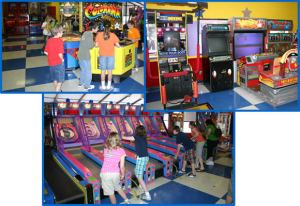Chaos at the arcade
September 4, 2011
A story about Schuyler’s class trip caught my attention.
This story happened to be posted the day after I went to a place similar to the one described* (skee ball, laser tag, mini-golf, etc.) so I could really visualize it. I spent most of the evening considering how such places could be accessed. It strikes me that the games themselves are highly structured, but the environment as a whole was open and chaotic.
No matter how much communication we give kids, it seems like these environments are not easy nuts to crack. Part of me is thinking of ways to structure to force more interaction (maybe teams see who gets the most tickets or something, then the problem of assigning teams…). The other part of me wonders if forcing it is ultimately counterproductive—that the self-directedness is the mission here and to reduce that
 Questions: Can you create a meta-game structure in a free-play environment that encourages more interaction for kids who don’t do well in unstructured social environments without the neurotypical kids pushing back against it or squashing the developmental benefits of the chaos?
Questions: Can you create a meta-game structure in a free-play environment that encourages more interaction for kids who don’t do well in unstructured social environments without the neurotypical kids pushing back against it or squashing the developmental benefits of the chaos?
* It is really weird that this was posted the day after my friend suggested impulsively, “Let’s go play skee ball.”